This is the first of a series of posts. These will be based around a collection of found photographs which were pointed out to me by a friend in possession of someone else I know who didn’t really know what to do with them. These were picked up at a jumble sale; a huge set of slides; some 400, around 60 of which are Norwich in the 1960s and 1970s which is where the unknown photographer hailed from we’d think. The rest are from holidays and trips, from Edinburgh to Kent. He or she shot on 120 film and had them converted to 56mm x 56mm glass sandwich slides, the quality is pretty astonishing. We can only guess what they were shot on, but the depth of field on them is fairly shallow in places and not in others which indicates it may have been a camera with a certain level of control over the apeture, the fact that most of them are well exposed also indicates that it was probably metered shooting, not guesswork with a hit and hope camera. Whoever he or she was knew what they were doing and had spent some money on gear, processing and storage. The condition of these now slightly over 50 year old pieces of film is good, some minor foxing and a few marks on the glass, but nothing that can’t be repaired.
They are quite remarkable in the same way that George Plunkett’s work is, as they seem to be a deliberate effort to record certain aspects of the city at a particular point in time, pretty much the same as I do and other people do. Some are specific events, others are buildings, and a few are at a point of change; things closing down, an archaeological dig, a city just before a large series of developments changed it. Some areas have altered dramatically. others are pretty much the same. Most of the Norwich photos appear to be from 1963 they feel like they may have been throughout a summer, a poster in one of a venue indicates June. Others are dated 1973.
What makes them special is they originate in an era when the camera was nowhere near as ubiquitous and everyday as it is now; most people didn’t carry one with them in their pocket, with a few exceptions such as folding cameras this wasn’t possible generally. This was also an era where the cachet of a photo becoming popular held no meaning unless you worked for the press or in advertising. These were shot by someone to record things for the sake of recording them. Seeing these gradually appear on-screen from a digital scanner is always rather magical. Now they have the opportunity to be seen and appreciated more widely, as well as rescued.
It would be nice to put a name to whoever stood behind the camera and stopped time for an instant. There are a few clues, people in some of the images, what could be his or her daughter.
With thanks to Charlie Wilson for pointing them out and Julie Chettleburgh for passing them on. It is important these things are seen, so here we go a selection of the more interesting ones.
Please note: Images on this website are covered by copyright and as such if they are going to be shared on Facebook or any other social media platform, need permission for use even under fair use policy, and MUST be credited with a link back to the page they appear on. Any infractions of this may result in DMCA takedown notice and may also result in an invoice being sent to the person or persons responsible for unlicensed use without permission.
Norwich 1960s, Part 1
Spitfire and Bloodhound missile outside the Bell Hotel.
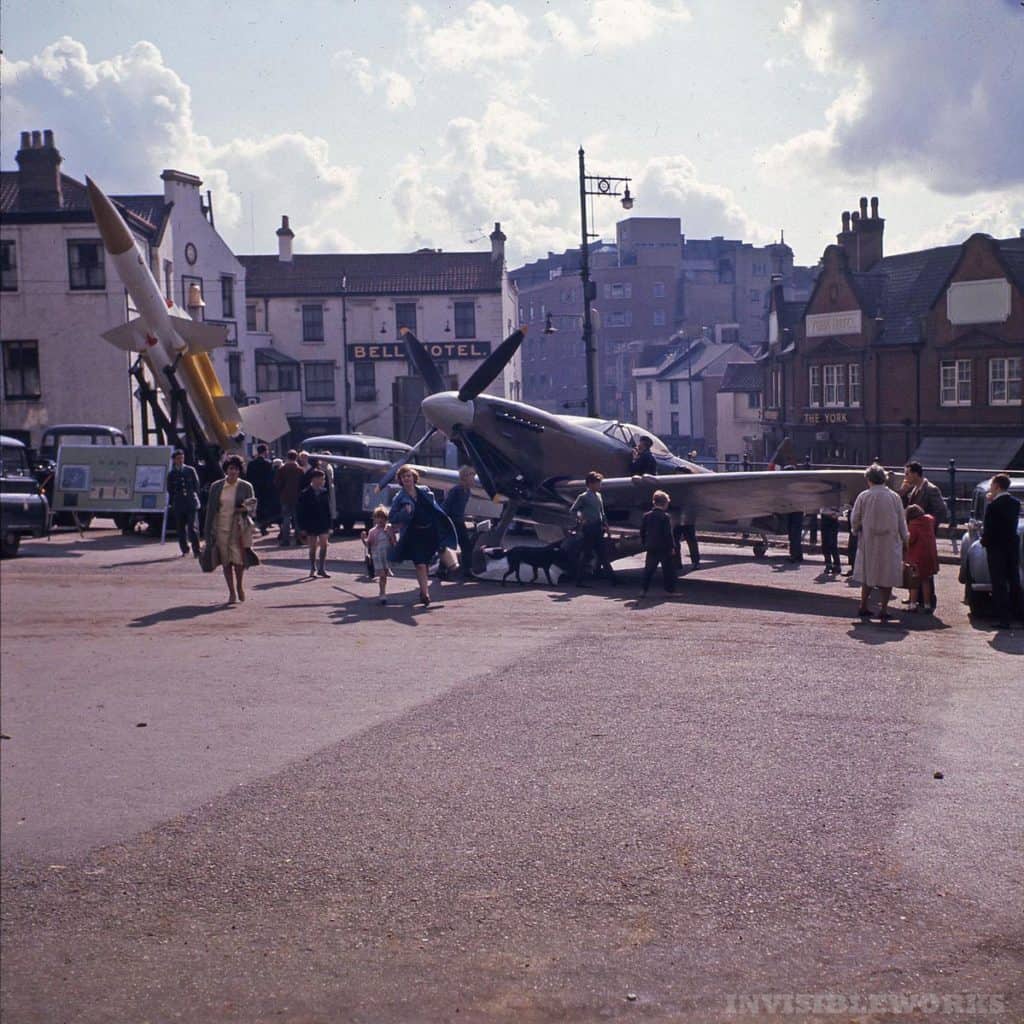
A curious shot which has already caused a few conversations as to exactly what might be going on. both are parked on what was then the Cattle Market, now inside part of Castle Mall. 1963 was the year what we now call the Battle of Britain Memorial Flight moved from RAF Horsham St Faiths to RAF Coltishall, where it stayed for about nine years. The Spitfire is a late mark, you can see from the cockpit cowling, It could be a Mk LF XVIE, and it is possible that it is TE311 which flew over the city in 2016 on Battle of Britain Day, which at the time was being used as a static display aircraft, if it is it had full elliptical wings at the time rather than clipped-wings as it does now. Note also York House was still York Hotel.
Lamberts Tea Warehouse, Haymarket.
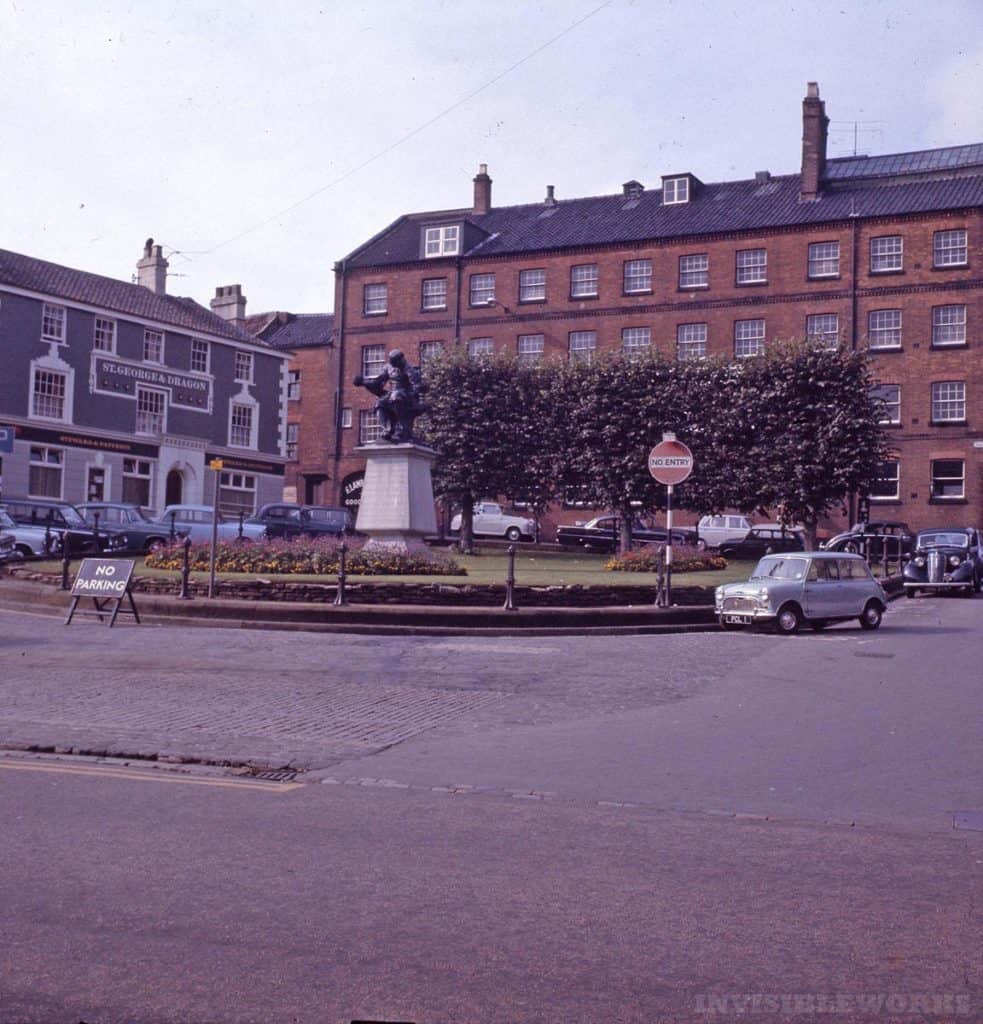
Now of course long gone, this is now next, formerly C&A. Thomas Browne’s statue is still in-situ on the green and there’s parking outside McDonalds which was then the George and Dragon Pub, below it out of shot the Haymarket Cinema, Norwich which was demolished in the 1960s. Lambert’s warehouse went the same way.
Ashworth and Pike Cafe and Restaurant, Davey Place.
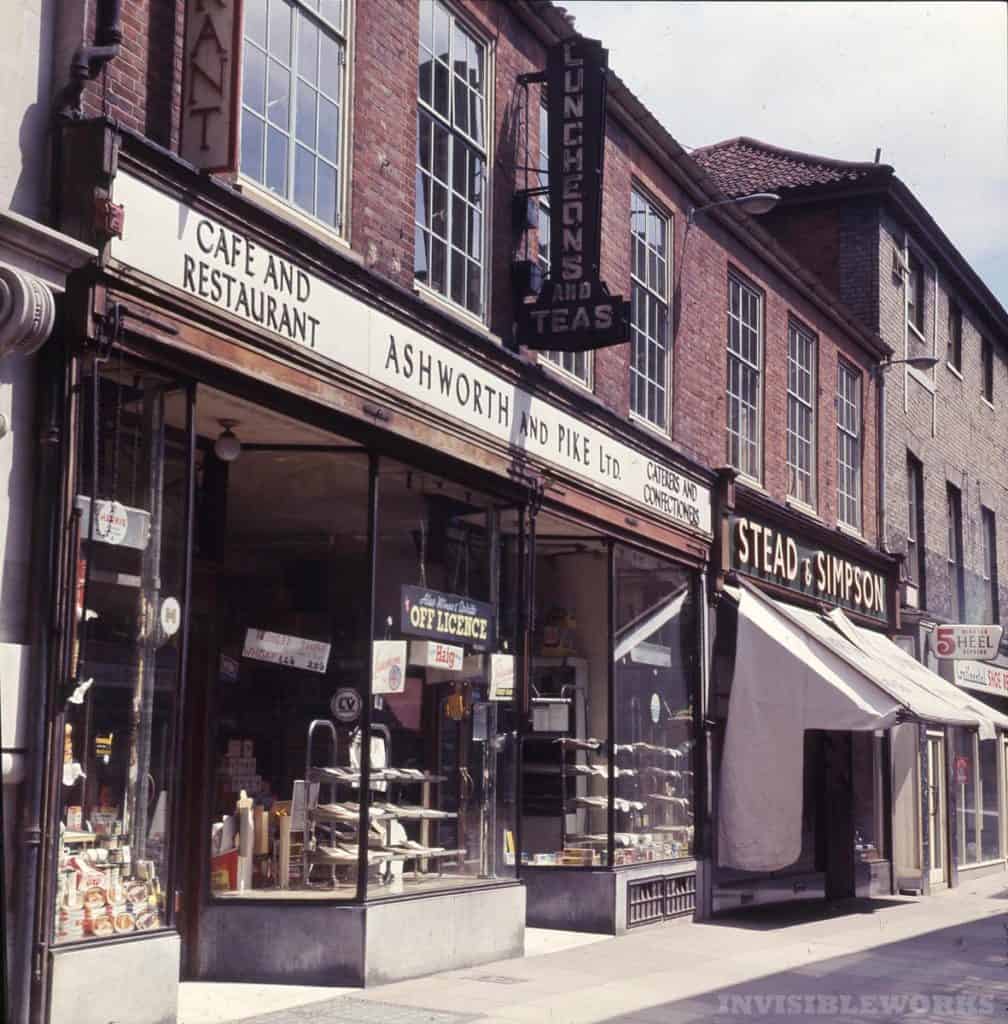
Shot looking in the direction of Castle Street, these are now Jessops, Animal and City Bookshop. Ashworth and Pike owned six shops in Norwich at their peak and ran a bakery and confectioners to supply them.
St Giles Gate, Upper St Giles.
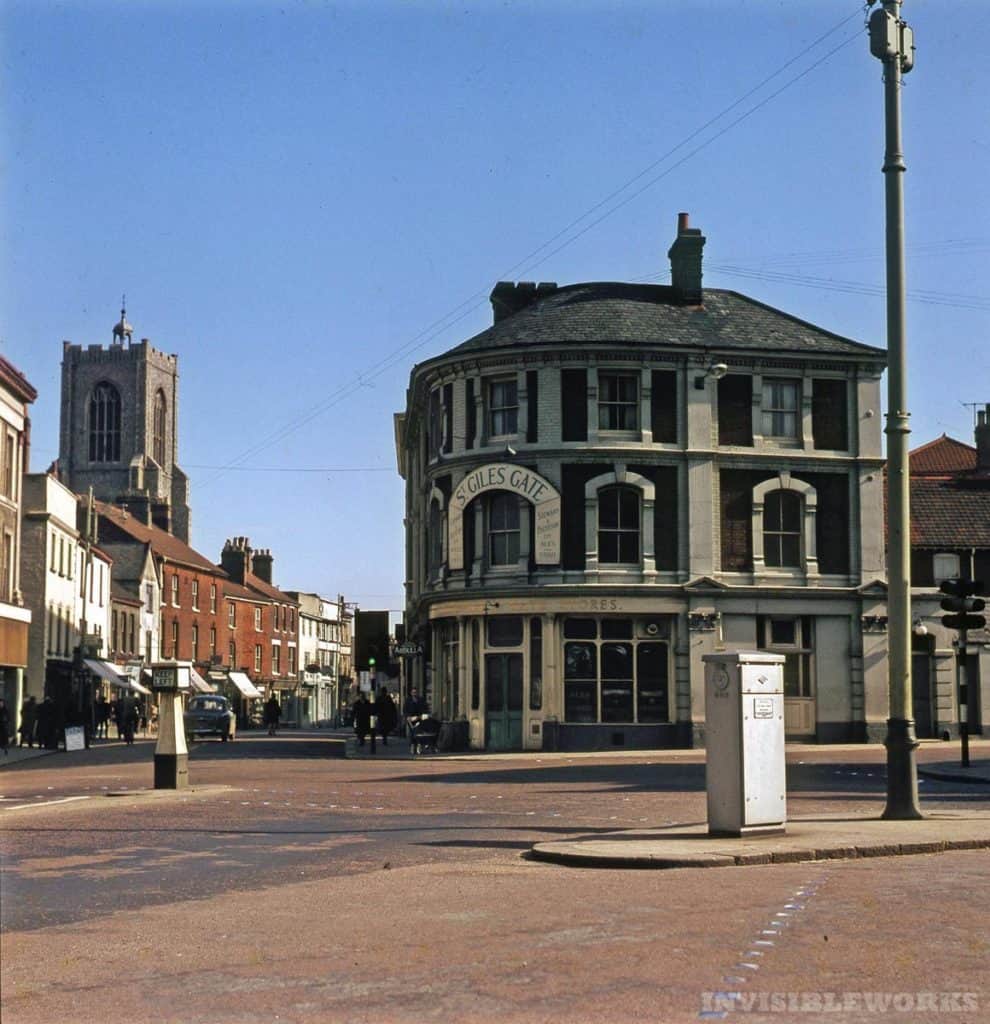
Formerly the St Giles Tavern this stood on the corner of Upper St Giles and the junction of Grapes Hill and Chapelfield Road, Norwich. Listed as licensed 1867 to 1965. The building was subject to a compulsory purchase order and demolished to make way for the ring-road. The original crossing here would have taken you straight onto Earlham Road and access to Unthank.
Foundry Bridge Cafe
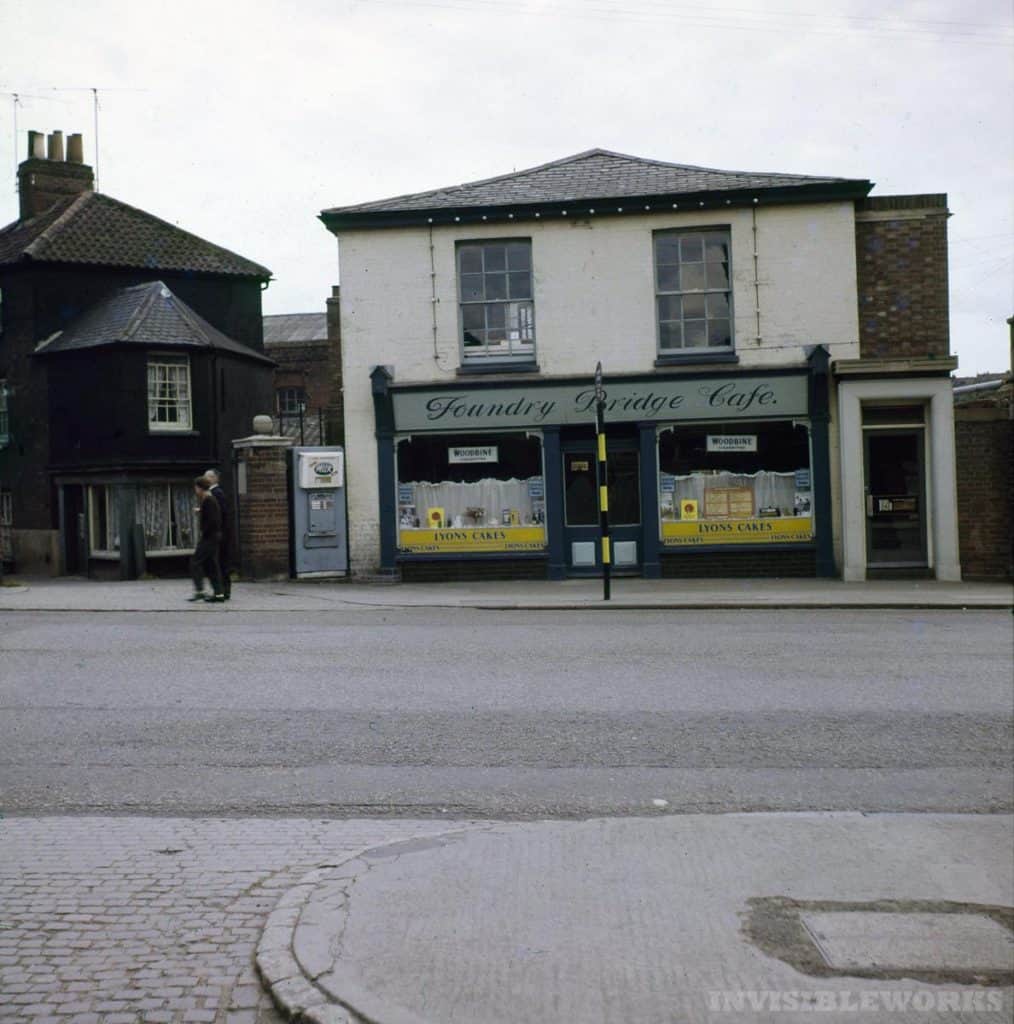
Exact location unknown, but if you look at the last photo at the next photo it appears to be the same building at the end before the Great Eastern Hotel, but early twentieth century adverts indicate it was ‘The first cafe over the bridge coming from Thorpe Station, Norwich – Salt Beef and Ham a specialty’. The proprietor in 1929 was M. Nattrass.
95 to 101 Prince of Wales Road.
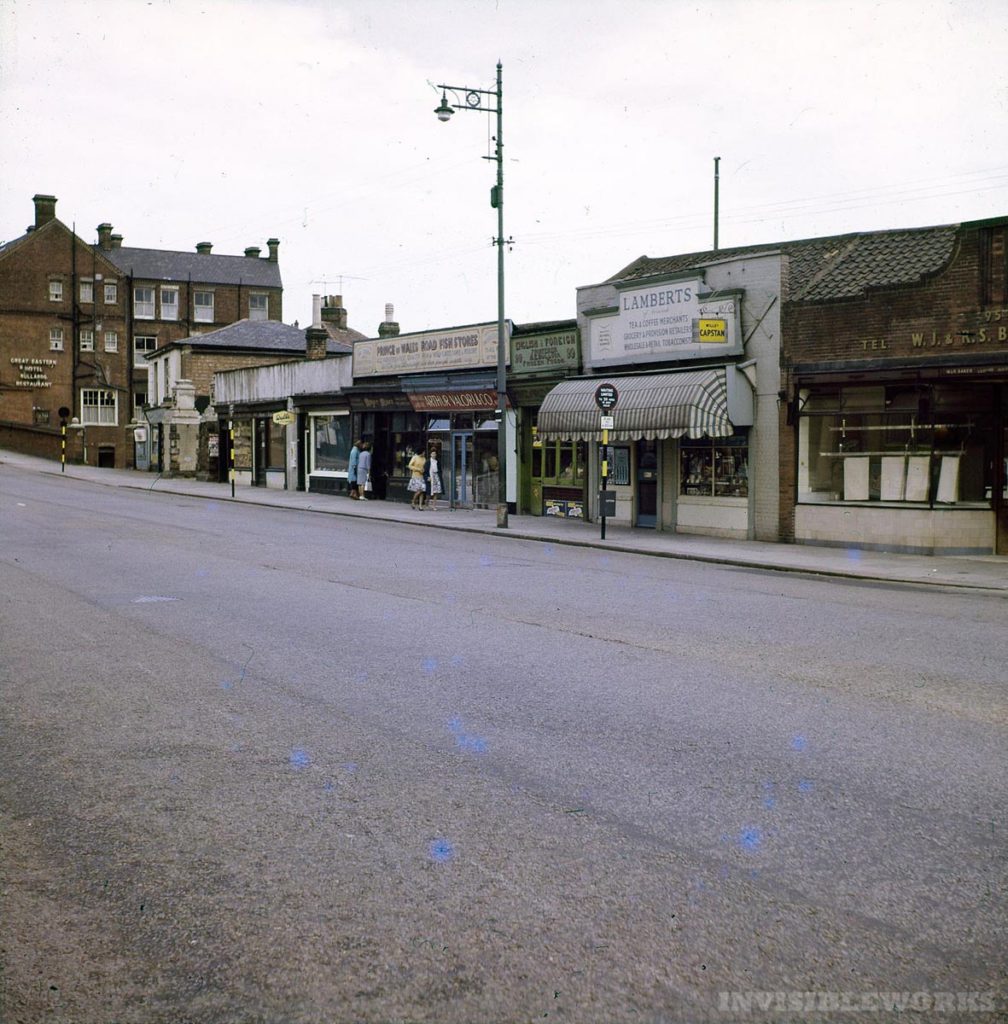
A nice littel assembly of slightly run down shops, left to right: Major Mace – Gold and Silver dealer, One of the many Valori fish shops; the Valori’s were one of the many early twentieth century Immigrant Italian families whose industriousness came to dominate certain trades in the city along with the Peruzzis, Carreras and Marcantonios. Bullocks Fruiterers, and another Lamberts tobacconists, ubiquitous across the whole of Norwich in the 1960s. All gone in a redevelopment in the 1960s.
F Lambert & Son – from St Andrew’s Broad Street.
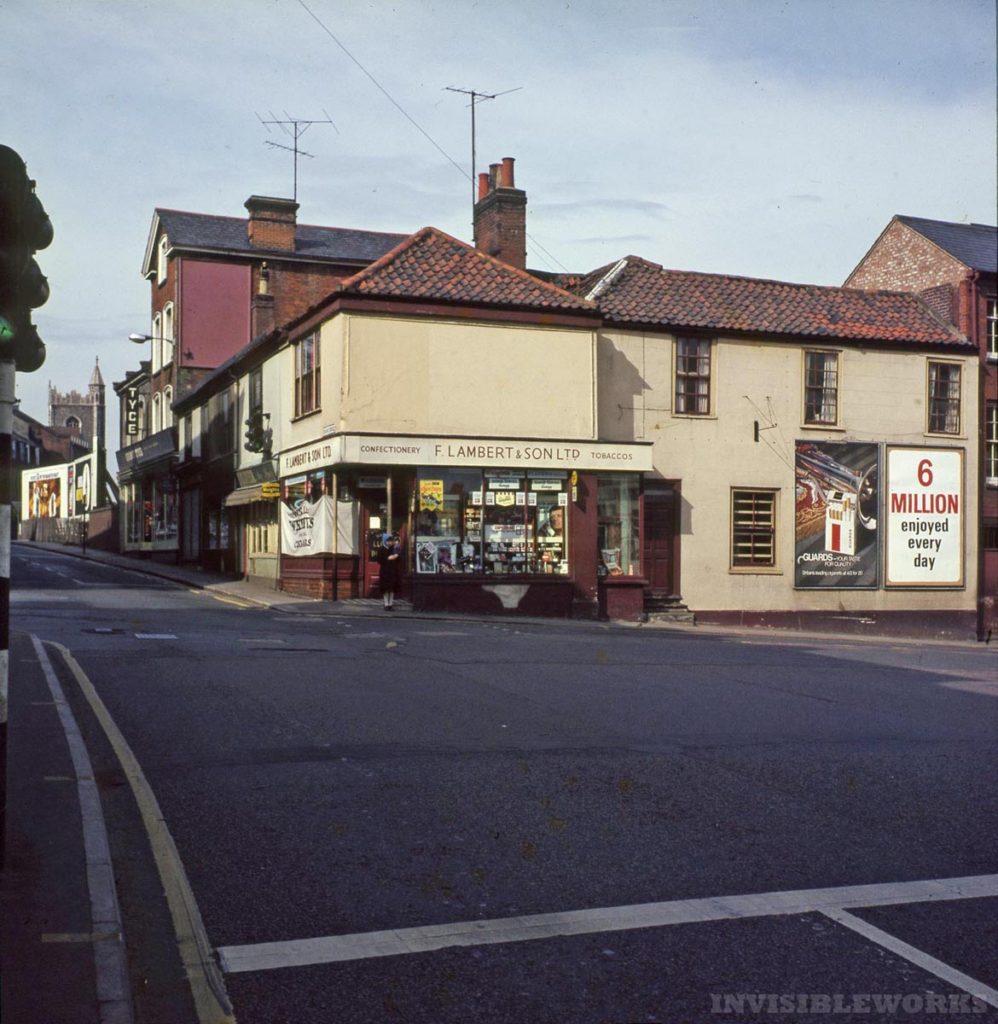
On the corner of the now widened St Andrews Braod Street (and Charing Cross) stood this little confectioner and tobacconist, another one of the Lambert stores which stood across the city. In the background to the right you can make out the tower of St Lawrence which stands between St Benedicts and Westwick Street.
The Great Eastern Hotel, Foundry Bridge
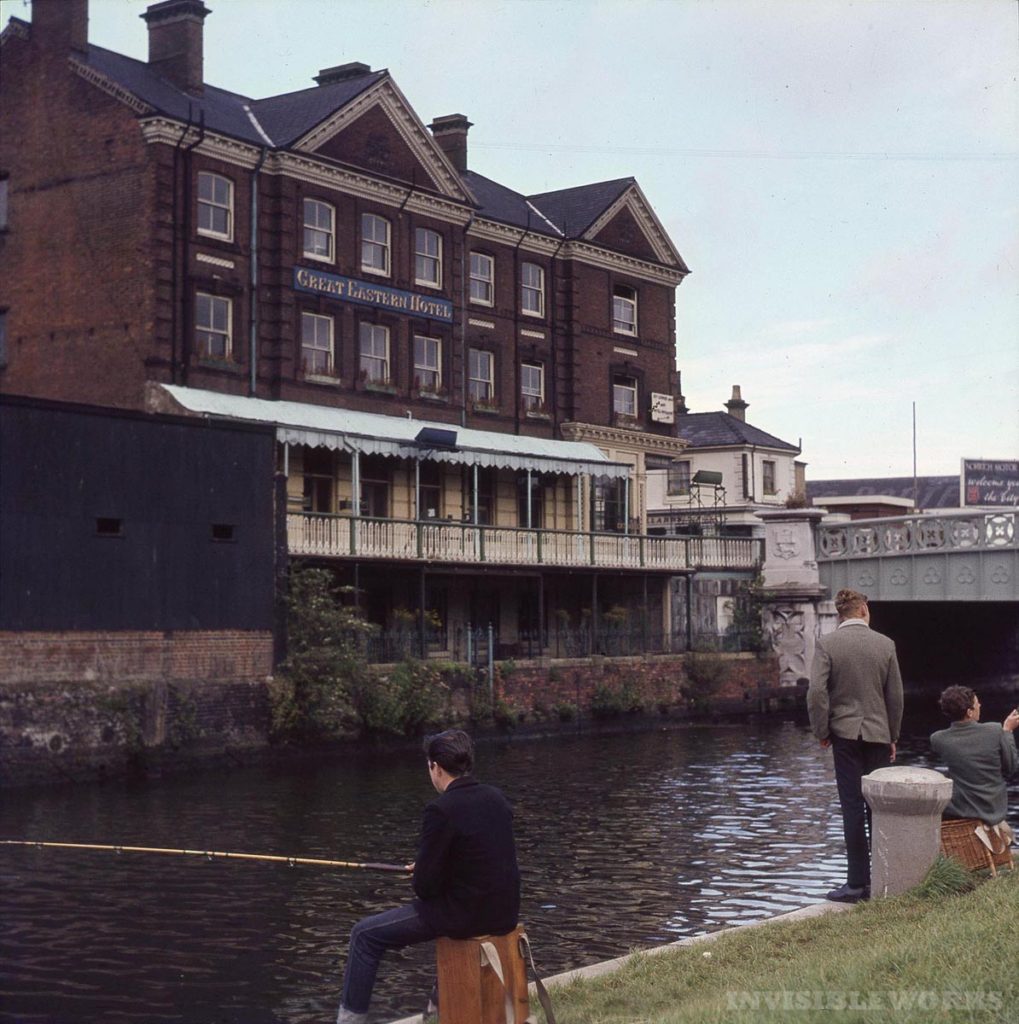
What is now Hotel Nelson Norwich, a Premier Inn as far as I’m aware. It was demolished in 1963.
Part 1 – is here
Part 2 – Norwich Pubs is here
Part 3 Norwich churches is here
Part 4 Norwich streets is here
Special thanks to Julie Chettleburgh.
© Invisible Works 2016

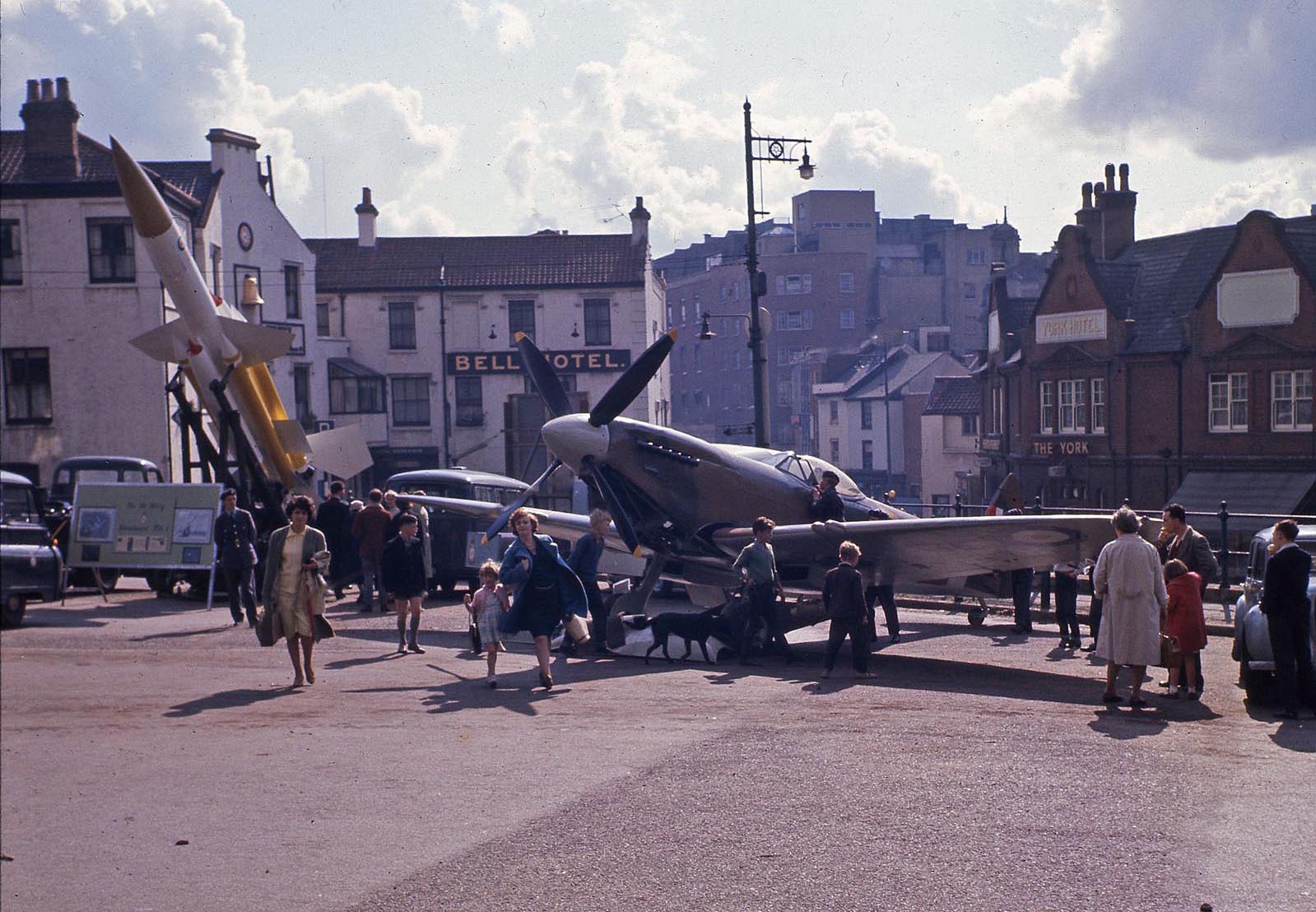
These are wonderful Nick! Looking forward to seeing more. It sounds like a few of these buildings were demolished not long after the photos were taken – do you think the photographer was intentionally trying to record those areas before they were redeveloped, or is it just that Norwich changed a lot in over the course of the decade?
It’s entirely possible, there certainly seems to be particular spaces being recorded, although there are also a lot of things like pubs, more on which later…
Fascinating. I really do appreciate your work.
After four years at Norwich Art School and two years National Service in the RAF my first job was at Willsmore and Tibbenham’s advertising agency on Thorpe Road. When we could afford it, my wage was £8.00 a week, I and good friends from the art studio would buy lunch at the Foundry Bridge Cafe. (My favourite dish on their menu was steamed ginger pudding drenched with a golden syrup sauce).
At the time I was also a photographer, painter and print maker with a particular interest in abstract qualities of shops etc., and their advertising banners, hoardings, etc. Often I would work from photos – and I started a painting of the Foundry Bridge Cafe. It would have been around 1964 as, to our dismay, the business about to close down.
After that my life got rather complicated. I eventually started my own business and found myself working very long hours and often at weekends. Something had to give and it was my painting. But I do have the unfinished work and reference photo and can see that the Foundry Bridge Cafe was to close Saturday March 14th (the year was not indicated). Sale of Equipment March 23 (On view March 2 10-4). The yellow Lyons Cakes banners at the bottom of the windows had been replaced by white ones from Coca-Cola and also advertised ‘Restaurant’ and ‘Lunches’. The street door to the right, marked 109B, gave access an architects office above.
Regarding location, you can see it on your photo 95 to 101 Prince of Wales Road very close to or next to the hotel – which I don’t remember as the Great Eastern (I’m checking on this).
And the painting. Yes, over 50 years after starting I do intend finishing it.
And regarding the Spitfire and Bloodhound parked near the Bell Hotel: I suggest that it would be linked to recruitment. I was one of the last to be conscripted into the RAF and National Service ended in 1963 – so the service would have found itself needing to boost numbers by attracting regulars.
Thanks Geoff, that’s absolutely fascinating. Do you have any photos from the era?
Dear Geoff
by sheer chance I came across your name. I was in the production dept at W & T from 1965 -67. I remember Michael Meakin who ran the print dept., and in fact I was his number 2 for a while. Other names I remember were Sid and Norman from the art dept. Gordon Lee who was the Production Manager, Doug Knibbs, Maurice Messenger and Richard Pytches. In your area there was John Nicholls who was a typographer; Derek Rowe and Len Ridge.
Then there were the girls in Business Information Ltd!! Oh Happy Days. Hope this message finds you well.
Loved these photos, no traffic. Well remember the Foundry Bridge Cafe where would have lunch most days, it kept me alive with meals at affordable prices, we were all paid so little working for W&T in Thorpe Road.
Richard Pytches
Isn’t it interesting how much more evocative a colour photo can be? These are fascinating records of lost Norwich as it had been in living memory. Great, Nick. Can’t wait to see the rest.
You keep posting them & I’ll keep enjoying them. Thank you Nick. A new brilliant series. I look forward to more. I started out with an Ilford 120 camera, which I could ‘adjust a bit’ and then funds and family stopped me until I became a Flickrite in about 2011.
They look like George Swain photo’s.
also a photographer for the EDP .
he was a friend of my Fathers , he had a photography shop in norwich ,
i have approximately 400 of his early slides .
It’s possible, although the photos are of the 1960s and 1970s and feature what I assume are the photographers children. I’ve met Judy George’s daughter a few times and this is I think a different generation. If you go back to George’s father George Senior the family are really interesting. From memory I think there were six children and I believe they were nearly all photographers, who spread across the country. His mother also took photos. I too have a large collection of George’s work, mostly prints of the Blitz, and a fair collection of his father’s work, plus some portraits by his mother. A hugely important family and in terms of recording social history in the city and county as important as Plunkett or Emerson.
The Spitfire is a Mk XVIe but the serial number is SL542. Nice image.
This Spitfire had been mounted on a pole at RAF Horsham St Faith and transferred to RAF Coltishall in 1963.
Here it was again mounted on a pole at the station entrance. It would seem that between poles it made an appearance at Norwich.
The date is most likely September 1963, the traditional month to commemorate the ending of the Battle of Britain.
Peter Arnold – Spitfire Historian
I lived in that cottage next to the cafe on Prince of Wales Rd
Fabulous photographs. Brought lots of memories back. I was a teenager in the 60s and my sister and I loved to visit a trendy shop in st stephens street. It was about half way up on the left side. Near it was a shop where you could listen to the latest pop music in a cubicle! What was that shop called? Can anyone remember it ?
Would the trendy shop be Chelsea Girl ?
I am so impressed by these photos. Takes me back to a time I didn’t even know!
Superb
vending machine that sold chilled jersey milk from jersey cattle kept at a village on the outskirts of norwich. Look at the blue machine set into the wall. Sixpenny piece would get you a waxed carboard carton of jersey milk and or kiora still orange. This was the first refrigerated vending machine in the uk. The pman who had it installed was Jack Linder of Linvend at mountegate st. He was a corn and seed merchant who would give credit terms such as plant it and on a shake collect the cost when the farmer harvested. Jack who had his MMB contract amongst the old fashioned run farms in south norfolk would never hear a bad word of his farmer friends. A shake meant something in those times. He lamented the loss of the heavy horses (Hosses) that were shot in the 50s with the tractor onset. They, the farmers wept like wenches to see them go. The ploughs and carts were designed for hosses built in the late 19th. They all went to scrap. The black smiths who went with the hosses never to open their doors again were gone with the wind. You had wheel wrights, cartwrights, and smiths who could put iron straps on elm wood axles when broken.
Brilliant photos. Very happy to see the shot of Charing Cross. My dad was born at No 7, in May1923.